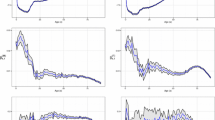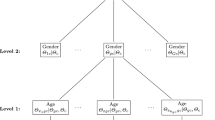Abstract
We propose a nested multi-population mortality projection model in which the forces of mortality are modelled via an extended version of the Cairns–Blake–Dowd model for middle and higher ages, and the resulting model parameters are forecast using a vector error correction model. Dependencies between different populations are accounted for by the joint parameter dynamics through lag coefficients (short-term predictability between the marginals), cointegration relations (long-run equilibriums), and error terms (correlated shocks). Bayesian inference assures integrated estimation and prediction of all hierarchical parameters in one step and allows for quantifying the underlying joint uncertainty. Our hierarchical set-up—yet flexible and easily interpretable—leads to a wider range of biologically plausible forecasts including, e.g., long-lasting, possibly varying discrepancies or phases of temporal divergence. We study two empirical examples in European mortality which suggest that the common a priori coherence assumption in actuarial projection models is too restrictive.









Similar content being viewed by others
Notes
The code is available upon request to the corresponding author.
For our application, we directly present the model with a constant deterministic trend per marginal time series. In general, the VECM allows for \(d \in {\mathbb {N}}\) deterministic trends through \(\phi D_t\) with time-varying constants \(D_t \in {\mathbb {R}}^{d}\) and parameter matrix \(\phi \in {\mathbb {R}}^{m \times d}\), e.g. by setting \(D_t = (1,t)^\prime \) and \(d=2\) to include time-varying trends. The matrix notation \({\varPhi }\) and the following Bayesian inference can be generalised accordingly.
The code is available upon request to the corresponding author.
References
Ahc̆an A, Medved D, Olivieri A, Pitacco E (2014) Forecasting mortality for small populations by mixing mortality data. Insur Math Econ 54:12–27
Antonio K, Bardoutsos A, Ouburg W (2015) Bayesian poisson log-bilinear models for mortality projections with multiple populations. Eur Actuar J 5(2):245–281
Biatat VD, Currie ID (2010) Joint models for classification and comparison of mortality in different countries. In: Proceedings of 25rd international workshop on statistical modelling. University of Glasgow, Glasgow, pp 89–94
Cairns AJ, Blake D, Dowd K (2006) A two-factor model for stochastic mortality with parameter uncertainty: theory and calibration. J Risk Insur 73(4):687–718
Cairns AJ, Blake D, Dowd K, Coughlan GD, Epstein D, Ong A, Balevich I (2009) A quantitative comparison of stochastic mortality models using data from England and Wales and the United States. N Am Actuar J 13(1):1–35
Cairns AJ, Blake D, Dowd K, Coughlan GD, Khalaf-Allah M (2011) Bayesian stochastic mortality modelling for two populations. Astin Bulletin 41(1):29–59
Czado C, Delwarde A, Denuit M (2005) Bayesian Poisson log-bilinear mortality projections. Insur Math Econ 36(3):260–284
Danesi IL, Haberman S, Millossovich P (2015) Forecasting mortality in subpopulations using Lee-Carter type models: a comparison. Insur Math Econ 62:151–161
Debón A, Chaves L, Haberman S, Villa F (2017) Characterization of between-group inequality of longevity in European Union countries. Insur Math Econ 75:151–165
Dowd K, Cairns AJ, Blake D, Coughlan GD, Epstein D, Khalaf-Allah M (2010a) Backtesting stochastic mortality models: an ex post evaluation of multiperiod-ahead density forecasts. N Am Actuar J 14(3):281–298
Dowd K, Cairns AJ, Blake D, Coughlan GD, Epstein D, Khalaf-Allah M (2010b) Evaluating the goodness of fit of stochastic mortality models. Insur Math Econ 47(3):255–265
Dowd K, Cairns AJ, Blake D, Coughlan GD, Khalaf-Allah M (2011) A gravity model of mortality rates for two related populations. N Am Actuar J 15(2):334–356
Enchev V, Kleinow T, Cairns AJ (2016) Multi-population mortality models: fitting, forecasting and comparisons. Scand Actuar J 1:1–24
Gaille S, Sherris M (2011) Modelling mortality with common stochastic long-run trends. Geneva Pap Risk Insur Issues Pract 36(4):595–621
Gilks WR (2005) Markov chain Monte Carlo. In: Armitage P, Colton T (eds) Encyclopedia of biostatistics, 2nd edn. Wiley, Chichester
Hatzopoulos P, Haberman S (2013) Common mortality modeling and coherent forecasts. An empirical analysis of worldwide mortality data. Insur Math Econ 52(2):320–337
Human Mortality Database (2014) University of California, Berkeley, California, and Max Planck Institute for Demographic Research, Rostock, Germany. http://www.mortality.org or http://www.humanmortality.de (data downloaded on 24 September 2014)
Jarner SF, Kryger EM (2011) Modelling adult mortality in small populations: the SAINT model. Astin Bull 41(2):377–418
Kleinow T (2015) A common age effect model for the mortality of multiple populations. Insur Math Econ 63:147–152
Li J (2013) A poisson common factor model for projecting mortality and life expectancy jointly for females and males. Popul Stud 67(1):111–126
Li J, Tickle L, Parr N (2016) A multi-population evaluation of the Poisson common factor model for projecting mortality jointly for both sexes. J Popul Res 33(4):333–360
Li N, Lee R (2005) Coherent mortality forecasts for a group of populations: an extension of the Lee-Carter method. Demography 42(3):575–594
Lütkepohl H (2007) New introduction to multiple time series analysis. Springer, Berlin
Milidonis A, Efthymiou M (2015) Mortality lead lags, working paper
Ntamjokouen A, Haberman S, Consigli G (2014) A multivariate approach to project the long run relationship between mortality indices for Canadian provinces. In: Perna C, Sibillo M (eds) Mathematical and statistical methods for actuarial sciences and finance. Springer International Publishing, Cham, pp 153–161
Reichmuth WH, Sarferaz S (2008) Bayesian demographic modeling and forecasting: an application to US mortality. Discussion Paper of Sonderforschungsbereich 649 (Economic Risk), Humboldt-Universität zu Berlin, Berlin
Villani M (2005) Bayesian reference analysis of cointegration. Econ Theory 21(2):326–357
Warne A (2006) Bayesian inference in cointegrated VAR models with applications to the demand for euro area M3. Working Paper Series of the European Central Bank, vol 692, pp 1–41
Wilson C (2001) On the scale of global demographic convergence 1950–2000. Popul Dev Rev 27(1):155–171
Zhou R, Wang Y, Kaufhold K, Li J, Tan K (2012) Modeling mortality of multiple populations with vector error correction models: applications to solvency II, working paper
Author information
Authors and Affiliations
Corresponding author
Additional information
Publisher's Note
Springer Nature remains neutral with regard to jurisdictional claims in published maps and institutional affiliations.
Electronic supplementary material
Below is the link to the electronic supplementary material.
Rights and permissions
About this article
Cite this article
Hahn, L.J., Christiansen, M.C. Mortality projections for non-converging groups of populations. Eur. Actuar. J. 9, 483–518 (2019). https://doi.org/10.1007/s13385-019-00213-1
Received:
Revised:
Accepted:
Published:
Issue Date:
DOI: https://doi.org/10.1007/s13385-019-00213-1




